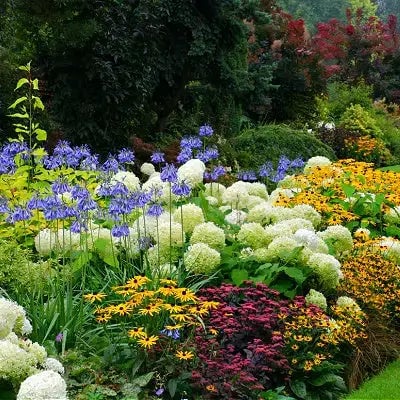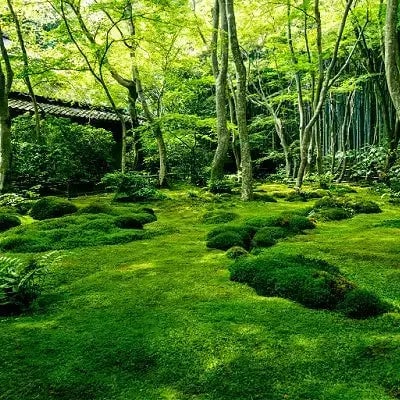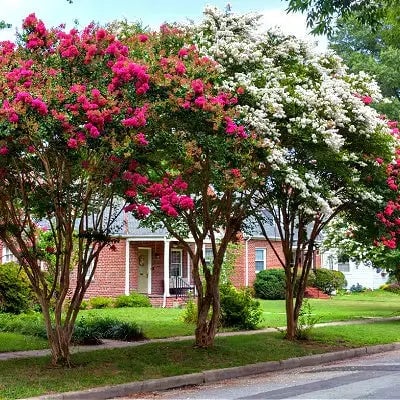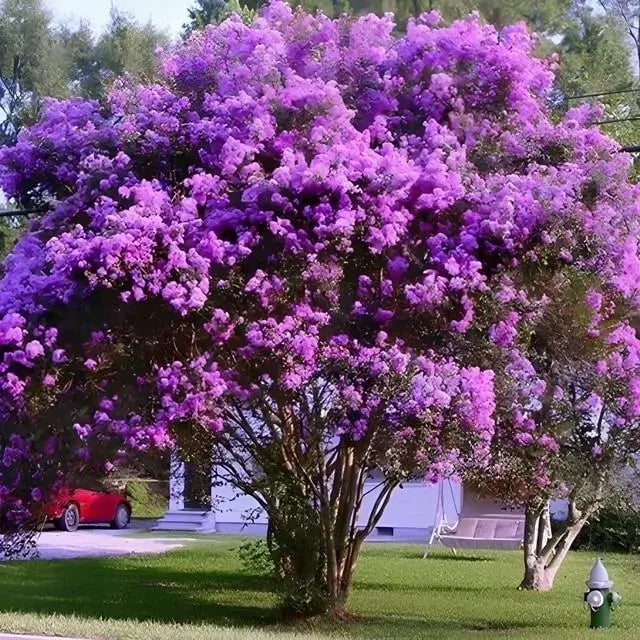Crepe myrtles, also known as Lagerstroemia indica, are popular in gardens for their paper-like petals that resemble crepe and beautiful bark. These trees or shrubs love full sun and well-drained soil, with a growth rate that can reach 6 to 30 feet high, depending on the variety chosen. They bloom from July to September with showy flowers in various colors: red, pink, white, and fuchsia.
Crepe myrtles can be used as hedges, privacy screens, or street trees. They attract bees and other pollinators and protect birds. These plants are generally resistant to deer, drought, and pollution. In terms of zones, they can grow in USDA Hardiness Zones 6-9.
If you're considering a crepe myrtle for your garden, here are four benefits you can expect. With proper maintenance on your end, you should notice these results:
Crepe Myrtle Trees Have Beautiful Flowers
Opt for red or white blooms. In certain soil conditions, the red blooms can take on a more pink appearance, even almost resembling a fuchsia hue. If you're looking for beautiful bright color, you will love the red blooms. White flowering crepe myrtles create a cleaner and more polished look in your yard.
Add the beautiful crepe myrtle trees to either commercial or residential properties to improve curb appeal. Their colorful, full blooms also look lovely next to driveways and pools. No matter where you place a crepe myrtle, look forward to many years of vibrant foliage each summer.
Crepe Myrtle Can Help Lower Your Energy Bills!
Yes, crepe myrtles can reduce energy bills! When planted next to commercial and residential properties, the branches from these trees and their blooms provide a lot of shade, reducing the amount of heat absorbed by buildings, therefore lowering cooling and heating costs.
Medicinal Benefits of the Crepe Myrtle
The crepe myrtle tree can also improve your health.
These trees contain compounds that can help prevent cancer cell growth and maintain bone health. The antioxidants and flavonoids present in crepe myrtle contribute to its anti-cancer properties, while the plant's rich mineral content supports bone strength and density.
If you grind the crepe myrtle flowers, you can apply them to minor burns or cuts for immediate relief. If you want to look deeper into chemistry, you can learn how to boil the flowers and use the resulting oil to treat the common cold!
Crepe myrtles have been linked with abilities to combat kidney issues, obesity, and symptoms associated with diabetes. Crepe myrtle is also used traditionally to address digestive problems like constipation, diarrhea, and urinary conditions.
The plant's compounds can help prevent premature aging, lower blood cholesterol levels, and aid in maintaining a healthy heart.
Crepe Myrtle Trees Are Perfect for Bird Watching
During summer and into early fall, you can expect to see crepe myrtle blooms most of the time. You have even more reasons to consider crepe myrtles if you are a bird lover.
The nature unfolding doesn't come to an end in colder months, so birds typically love to feast on the crepe myrtle tree's seeds each winter. Cardinals, finches, juncos, and sparrows are known to feed off of crepe myrtles.
Dedicating a Part of Your Yard to Crepe Myrtles
Creating a crepe myrtle space in your garden can enrich your landscape while providing multiple ecological advantages. Whether grown as trees or shrubs through pruning and cultivation, these plants earn praise for their striking flowers, appealing bark, and minimal maintenance requirements. Crepe myrtles can completely change your garden's appearance regardless of whether you have a tiny or expansive space. Choose crepe myrtles as your garden's centerpiece because this guide explains their advantages and care methods.
The primary appeal of crepe myrtles lies in their remarkable flower displays. The crepe myrtle flowers bloom mid to late summer and remain vibrant in pink, red, white, or lavender shades for several weeks. You benefit from selecting different crepe myrtle cultivars to achieve a breathtaking array of colors when you allocate a specific area for them. Some gardeners plant crepe myrtles in a single-color scheme, like various shades of pink, while others select multiple cultivars to demonstrate the tree's entire color range. These flowers create a striking visual display that transforms any small yard into a glamorous showplace, no matter your taste.
Crepe myrtles stand out as low-maintenance flowering trees compared to numerous other varieties. Because of their excellent heat tolerance, crepe myrtles become particularly favored in hot summers. After they become established, these plants do not need regular watering but benefit from thorough watering when drought conditions persist. Crepe myrtles grow successfully across different soil types as long as proper drainage exists. The adaptability of these trees allows gardeners to allocate part of their yard to them since they require minimal maintenance regardless of gardening experience level.
Proper spacing is essential when organizing a dedicated area for crepe myrtles. When planting multiple specimens, leave sufficient space between them so they won't compete for sunlight or their root systems won't interfere. The height of crepe myrtles varies between six feet and twenty feet based on the cultivar selected. Small dwarf varieties make good fits for compact yards, whereas taller varieties serve well for designing garden borders or establishing an attractive tree-lined walkway. To achieve a tree-like structure for crepe myrtles, you need to prune them accordingly; maintaining their natural bushy shape only requires light pruning during late winter.
When you create a dedicated space for crepe myrtles in your garden, consider how they complement existing plants and landscape elements. The dramatic summer blooms of these flowers work well with perennial garden beds that match or contrast with their colors. Planting a row of crepe myrtles alongside smaller shrubs or ornamental grasses creates a tall, visually appealing backdrop that enhances your landscape design. The bark of crepe myrtles naturally peels back to display multicolored layers in tan, gray, and occasionally cinnamon tones that maintain visual appeal throughout the year, even when the trees lack flowers.
Creating a crepe myrtle corner or grove will draw pollinators to your garden space. Crepe myrtles may not feature prominently on lists of top pollinator plants, but their flowers provide nectar, which helps create a more vibrant and biodiverse environment. Populating your garden space with crepe myrtles establishes a unified visual theme while delivering positive environmental impacts.
Your crepe myrtle area will stay both healthy and beautiful with proper care. Early spring fertilizing and periodic watering produce more substantial plant growth and abundant flowering. Remove dead branches and suckers near the base in late winter or during early spring before the tree starts growing again. Keep an eye on your plants to watch for pests like aphids and scale, but manage infestations with ladybugs or horticultural oils to avoid harsh chemical treatments.
The combination of crepe myrtles' enduring colorful flowers and signature multicolored bark ensures they dominate any garden space. Allocating a section of your garden to these stunning trees creates a striking ornamental feature and makes gardening tasks easier because they need little maintenance after establishment. Crepe Myrtles can transform your outdoor living space with seasonal beauty and natural drama when you plant towering trees along a fence line or dwarf varieties in a garden corner.
Read more

TN Nurseries best selling perennials1. Indian pinks2. Virginia bluebells3. Phlox4. Jacobs ladder5. VioletsPerennial Plants are most loved for flower beds and gardens. Unlike annual plants, they hav...

Moss For Sale - Lowest Prices and Fastest Shipping Online - We Ship Nationwide Looking for premium quality moss? We have it. We don't spice up our moss images, and we show you unedited mosses that ...






